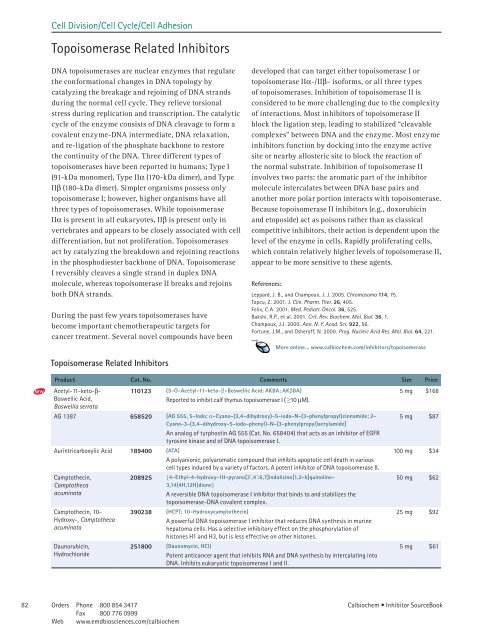Inhibitor SourceBook™ Second Edition
Inhibitor SourceBook™ Second Edition
Inhibitor SourceBook™ Second Edition
You also want an ePaper? Increase the reach of your titles
YUMPU automatically turns print PDFs into web optimized ePapers that Google loves.
Cell Division/Cell Cycle/Cell Adhesion<br />
Topoisomerase Related <strong>Inhibitor</strong>s<br />
DNA topoisomerases are nuclear enzymes that regulate<br />
the conformational changes in DNA topology by<br />
catalyzing the breakage and rejoining of DNA strands<br />
during the normal cell cycle. They relieve torsional<br />
stress during replication and transcription. The catalytic<br />
cycle of the enzyme consists of DNA cleavage to form a<br />
covalent enzyme-DNA intermediate, DNA relaxation,<br />
and re-ligation of the phosphate backbone to restore<br />
the continuity of the DNA. Three different types of<br />
topoisomerases have been reported in humans; Type I<br />
(91-kDa monomer), Type IIa (170-kDa dimer), and Type<br />
IIb (180-kDa dimer). Simpler organisms possess only<br />
topoisomerase I; however, higher organisms have all<br />
three types of topoisomerases. While topoisomerase<br />
IIa is present in all eukaryotes, IIb is present only in<br />
vertebrates and appears to be closely associated with cell<br />
differentiation, but not proliferation. Topoisomerases<br />
act by catalyzing the breakdown and rejoining reactions<br />
in the phosphodiester backbone of DNA. Topoisomerase<br />
I reversibly cleaves a single strand in duplex DNA<br />
molecule, whereas topoisomerase II breaks and rejoins<br />
both DNA strands.<br />
During the past few years topoisomerases have<br />
become important chemotherapeutic targets for<br />
cancer treatment. Several novel compounds have been<br />
Topoisomerase Related <strong>Inhibitor</strong>s<br />
developed that can target either topoisomerase I or<br />
topoisomerase IIa-/IIb- isoforms, or all three types<br />
of topoisomerases. Inhibition of topoisomerase II is<br />
considered to be more challenging due to the complexity<br />
of interactions. Most inhibitors of topoisomerase II<br />
block the ligation step, leading to stabilized “cleavable<br />
complexes” between DNA and the enzyme. Most enzyme<br />
inhibitors function by docking into the enzyme active<br />
site or nearby allosteric site to block the reaction of<br />
the normal substrate. Inhibition of topoisomerase II<br />
involves two parts: the aromatic part of the inhibitor<br />
molecule intercalates between DNA base pairs and<br />
another more polar portion interacts with topoisomerase.<br />
Because topoisomerase II inhibitors (e.g., doxorubicin<br />
and etoposide) act as poisons rather than as classical<br />
competitive inhibitors, their action is dependent upon the<br />
level of the enzyme in cells. Rapidly proliferating cells,<br />
which contain relatively higher levels of topoisomerase II,<br />
appear to be more sensitive to these agents.<br />
References:<br />
Leppard, J. B., and Champoux, J. J. 2005. Chromosoma 114, 75.<br />
Topcu, Z. 200 . J. Clin. Pharm. Ther. 26, 405.<br />
Felix, C.A. 200 . Med. Pediatr. Oncol. 36, 525.<br />
Bakshi, R.P., et al. 200 . Crit. Rev. Biochem. Mol. Biol. 36, .<br />
Champoux, J.J. 2000. Ann. N. Y. Acad. Sci. 922, 56.<br />
Fortune, J.M., and Osheroff, N. 2000. Prog. Nucleic Acid Res. Mol. Biol. 64, 22 .<br />
Product Cat. No. Comments Size Price<br />
N Acetyl- -keto-b-<br />
Boswellic Acid,<br />
Boswellia serrata<br />
110123 (3-O-Acetyl-11-keto-b-Boswellic Acid; AKBA; AKbBA)<br />
Reported to inhibit calf thymus topoisomerase I ( ≥ 0 mM).<br />
AG 387 658520 [AG 555, 5-Iodo; a-Cyano-(3,4-dihydroxy)-5-iodo-N-(3-phenylpropyl)cinnamide; 2-<br />
Cyano-3-(3,4-dihydroxy-5-iodo-phenyl)-N-(3-phenylpropyl)acrylamide]<br />
Aurintricarboxylic Acid 189400 (ATA)<br />
Camptothecin,<br />
Camptotheca<br />
acuminata<br />
Camptothecin, 0-<br />
Hydroxy-, Camptotheca<br />
acuminata<br />
Daunorubicin,<br />
Hydrochloride<br />
An analog of tyrphostin AG 555 (Cat. No. 658404) that acts as an inhibitor of EGFR<br />
tyrosine kinase and of DNA topoisomerase I.<br />
A polyanionic, polyaromatic compound that inhibits apoptotic cell death in various<br />
cell types induced by a variety of factors. A potent inhibitor of DNA topoisomerase II.<br />
208925 {4-Ethyl-4-hydroxy-1H-pyrano[3´,4´:6,7]indolizino[1,2-b]quinoline-<br />
3,14(4H,12H)dione}<br />
More online... www.calbiochem.com/inhibitors/topoisomerase<br />
A reversible DNA topoisomerase I inhibitor that binds to and stabilizes the<br />
topoisomerase-DNA covalent complex.<br />
390238 (HCPT; 10-Hydroxycamptothecin)<br />
A powerful DNA topoisomerase I inhibitor that reduces DNA synthesis in murine<br />
hepatoma cells. Has a selective inhibitory effect on the phosphorylation of<br />
histones H and H3, but is less effective on other histones.<br />
251800 (Daunomycin, HCl)<br />
Potent anticancer agent that inhibits RNA and DNA synthesis by intercalating into<br />
DNA. Inhibits eukaryotic topoisomerase I and II.<br />
5 mg $ 68<br />
5 mg $87<br />
00 mg $34<br />
50 mg $62<br />
25 mg $92<br />
5 mg $6<br />
82 Orders Phone 800 854 34 7<br />
Calbiochem • <strong>Inhibitor</strong> SourceBook<br />
Fax 800 776 0999<br />
Web www.emdbiosciences.com/calbiochem



